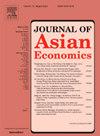How does the spatial agglomeration of human capital affect strategic innovation in China?
IF 2.9
3区 经济学
Q1 ECONOMICS
引用次数: 0
Abstract
This study investigates whether and how the spatial agglomeration of human capital affects strategic innovation, as measured by invention patents in strategic emerging industries in China. We also evaluate the aggregate effects of human capital allocation between 2000 and 2020 on strategic innovation based on the estimates. The results show that increases in human capital density significantly promote strategic innovation. On average, a 1 % increase in the densities of knowledge and technology talents contributes to an increase in strategic innovation by 0.19 % and 0.11 %, respectively. We further reveal that the agglomeration effects largely originate from the improvements in labor market matching and knowledge spillovers. Counterfactual analysis indicates that the spatial agglomeration of human capital would increase the overall strategic innovation by at least 1.36 % over the 2000–2020 period.
人力资本空间集聚如何影响中国战略创新?
本文以中国战略性新兴产业的发明专利为研究对象,考察人力资本的空间集聚对战略创新的影响。在此基础上,评估了2000 - 2020年人力资本配置对战略创新的总体影响。结果表明,人力资本密度的增加对战略创新有显著的促进作用。平均而言,知识和技术人才密度每增加1 %,战略创新就会分别增加0.19 %和0.11 %。集聚效应主要来源于劳动力市场匹配和知识溢出的改善。反事实分析表明,2000-2020年人力资本空间集聚对整体战略创新的拉动作用至少为1.36% %。
本文章由计算机程序翻译,如有差异,请以英文原文为准。
求助全文
约1分钟内获得全文
求助全文
来源期刊

Journal of Asian Economics
ECONOMICS-
CiteScore
4.70
自引率
9.40%
发文量
90
期刊介绍:
The Journal of Asian Economics provides a forum for publication of increasingly growing research in Asian economic studies and a unique forum for continental Asian economic studies with focus on (i) special studies in adaptive innovation paradigms in Asian economic regimes, (ii) studies relative to unique dimensions of Asian economic development paradigm, as they are investigated by researchers, (iii) comparative studies of development paradigms in other developing continents, Latin America and Africa, (iv) the emerging new pattern of comparative advantages between Asian countries and the United States and North America.
 求助内容:
求助内容: 应助结果提醒方式:
应助结果提醒方式:


